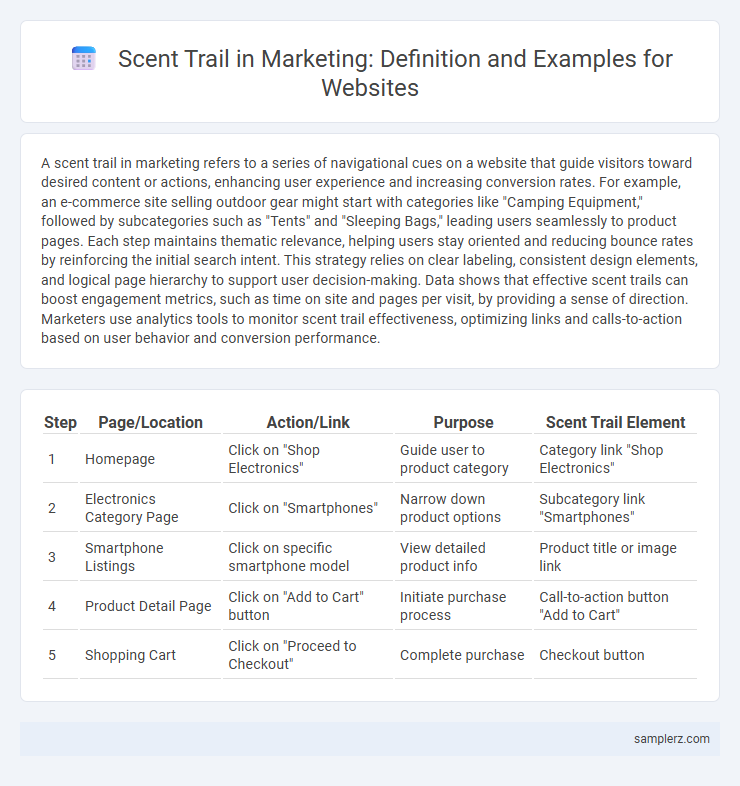A scent trail in marketing refers to a series of navigational cues on a website that guide visitors toward desired content or actions, enhancing user experience and increasing conversion rates. For example, an e-commerce site selling outdoor gear might start with categories like "Camping Equipment," followed by subcategories such as "Tents" and "Sleeping Bags," leading users seamlessly to product pages. Each step maintains thematic relevance, helping users stay oriented and reducing bounce rates by reinforcing the initial search intent. This strategy relies on clear labeling, consistent design elements, and logical page hierarchy to support user decision-making. Data shows that effective scent trails can boost engagement metrics, such as time on site and pages per visit, by providing a sense of direction. Marketers use analytics tools to monitor scent trail effectiveness, optimizing links and calls-to-action based on user behavior and conversion performance.
Table of Comparison
| Step | Page/Location | Action/Link | Purpose | Scent Trail Element |
|---|---|---|---|---|
| 1 | Homepage | Click on "Shop Electronics" | Guide user to product category | Category link "Shop Electronics" |
| 2 | Electronics Category Page | Click on "Smartphones" | Narrow down product options | Subcategory link "Smartphones" |
| 3 | Smartphone Listings | Click on specific smartphone model | View detailed product info | Product title or image link |
| 4 | Product Detail Page | Click on "Add to Cart" button | Initiate purchase process | Call-to-action button "Add to Cart" |
| 5 | Shopping Cart | Click on "Proceed to Checkout" | Complete purchase | Checkout button |
Understanding Scent Trail in Website Navigation
Scent trail in website navigation refers to the visual and contextual cues that guide users through web pages, helping them understand their location and available options. Effective scent trails improve user experience by reducing confusion and making it easier to find relevant information, which increases engagement and conversion rates. Examples include breadcrumb navigation, highlighted menu items, and consistent labeling that reinforce the user's path within the site.
Importance of Scent Trail for User Experience
A well-designed scent trail on a website guides users through content hierarchies, enhancing navigation and reducing cognitive load. Clear breadcrumb trails improve user experience by providing context and enabling seamless backtracking, which decreases bounce rates and increases engagement. Effective scent trails also boost conversion rates by helping users quickly find relevant products or information, fostering satisfaction and loyalty.
Classic Example: Amazon’s Breadcrumb Navigation
Amazon's breadcrumb navigation exemplifies a classic scent trail by clearly displaying a user's path through product categories, such as Home > Electronics > Cameras > Digital Cameras. This structure enhances user experience by providing context and easy navigation back to broader categories, reducing bounce rates and increasing engagement. Implementing similar breadcrumb trails on e-commerce websites improves findability and supports intuitive browsing, leading to higher conversion rates.
Scent Trail in E-commerce Product Pages
Scent trail in e-commerce product pages refers to the strategic use of visual and textual cues that guide customers through the purchase journey, enhancing engagement and reducing bounce rates. Implementing consistent color schemes, breadcrumb navigation, and persuasive product descriptions creates a seamless path that encourages users to explore related products and increase conversion rates. Optimizing scent trails aligns user intent with product offerings, ultimately boosting average order value and customer satisfaction.
Utilizing Icons and Colors for Scent Trail Cues
Utilizing icons and colors effectively creates a strong scent trail on websites, guiding users intuitively through navigation paths and content categories. For example, color-coded icons representing different product categories or service features enhance visual recognition and reduce cognitive load during browsing. This approach increases user engagement and conversion rates by maintaining clear and consistent visual cues throughout the user journey.
Consistent Call-to-Action Buttons as Scent Trail
Consistent call-to-action buttons create a clear scent trail that guides users seamlessly through a website, increasing conversion rates by reducing cognitive load. By using uniform colors, shapes, and placement for CTAs, visitors quickly recognize actionable elements and are encouraged to proceed with desired actions. This strategic design strengthens user experience and leads to higher engagement and sales.
Case Study: Scent Trail on Booking Websites
Booking websites utilize scent trails by highlighting previous search filters, hotel preferences, and location choices to guide users seamlessly through their booking journey. Case studies show that integrating scent trails increases user engagement and conversion rates by reducing friction and reinforcing decision-making cues. Data from major platforms reveal a 15-25% uplift in completed bookings when scent trails are strategically implemented in the user experience design.
Scent Trail Optimization for Mobile Users
Scent trail optimization for mobile users involves designing clear, concise navigation paths that guide visitors seamlessly through a website, enhancing user experience and increasing conversion rates. Techniques include simplifying menus, using descriptive icons, and maintaining consistent visual cues tailored to smaller screens to prevent user frustration and abandonment. Effective scent trails leverage mobile-friendly layouts and fast loading times to keep users engaged and encourage deeper exploration of marketing content.
Common Mistakes in Scent Trail Implementation
Many websites fail to provide a clear scent trail, causing users to lose track of their navigation path and increasing bounce rates. Common mistakes include inconsistent breadcrumb structures, lack of visual cues, and poorly labeled links that confuse visitors. Optimizing scent trails with intuitive design and clear hierarchies improves user experience and boosts conversion rates.
Best Practices to Enhance Scent Trail Effectiveness
Implement clear navigation paths and consistent visual cues to strengthen the scent trail, guiding users seamlessly through key website sections. Incorporate descriptive URLs and breadcrumb trails to reinforce the user's sense of location and facilitate easy backtracking. Optimize load times and maintain design consistency across pages to reduce friction and sustain user engagement along the scent trail.

example of scent trail in website Infographic
 samplerz.com
samplerz.com